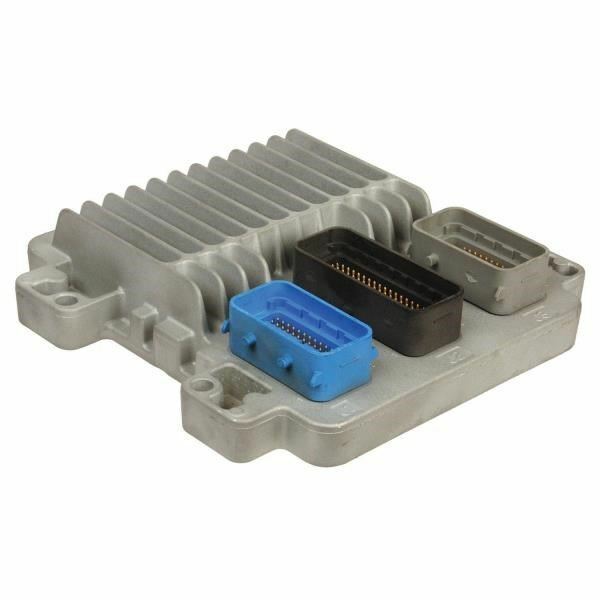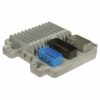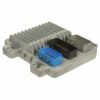Is Your GM Vehicle Running Rough? The Engine Control Module Could Be the Culprit.
If your 2005 Chevrolet SSR, Corvette, GTO, or other compatible GM truck or SUV is suffering from mysterious issues like a persistent check engine light, stalling, poor fuel mileage, or a no-start condition, the problem may lie in the very heart of its electronic systems: the Engine Control Module (ECM). As the central computer for your vehicle’s powertrain, a failing ECM can cause a cascade of frustrating and difficult-to-diagnose symptoms. This replacement Engine Control Module, part number 12597883, is the definitive solution to restore your vehicle’s performance, reliability, and drivability.
From the Diagnostic Bay
We had a 2005 Trailblazer EXT with the 5.3L V8 come in on a tow truck. The owner said it would run fine for about 15 minutes, then suddenly stall and refuse to restart for an hour. There were no consistent trouble codes, just a few random communication errors. After hours of checking fuel pressure, spark, and wiring harnesses, we hooked up a scope to the injector driver circuits inside the original ECM. We found that as the module heated up, one of the driver circuits would fail, cutting fuel to a cylinder and causing the stall. Replacing the ECM with a properly programmed unit like this one solved the problem instantly. It’s a classic example of how an internal ECM failure can mimic a dozen other issues.
Symptoms of a Failing Engine Control Module
- ✔ Persistent Check Engine Light: The light stays on even after clearing codes, or codes related to ECM internal failure (like P0601-P0606) are present.
- ✔ Engine Performance Issues: You may experience random misfires, rough idling, hesitation during acceleration, or a noticeable loss of power.
- ✔ No-Start or Hard-Starting: The engine cranks but won’t start, or takes an unusually long time to fire up, either hot or cold.
- ✔ Poor Fuel Economy: A faulty ECM can’t properly calculate the air-fuel mixture, leading to a sudden and significant drop in MPG.
- ✔ Automatic Transmission Problems: The ECM works with the TCM (Transmission Control Module), and a failure can lead to harsh shifting, getting stuck in gear, or incorrect shift points.
- ✔ Communication Failures: Your diagnostic scan tool may be unable to communicate with the ECM, making diagnosis impossible.
The Perfect Solution: A VIN-Programmed 2005 SSR Engine Control Module
What makes this module the best choice for your repair is our professional programming service. We don’t just send you a generic part off the shelf. When you place your order, you provide us with your vehicle’s 17-digit Vehicle Identification Number (VIN). Our technicians then use that VIN to load the latest, most stable GM-approved software calibration specifically for your vehicle’s make, model, engine, and options. This process ensures that the ECM works seamlessly with your existing systems, just as it did from the factory.
This critical programming step eliminates the need for an expensive trip to the dealership and the use of their specialized tools. For many of the compatible vehicles, installation is a straightforward plug-and-play process. In some cases, a simple security relearn procedure (often called a CASE relearn) may be necessary, which can typically be done without special tools. This module is a direct replacement for a range of service numbers, including 12578554, 12596771, 12597191, 12597883, and 19210071, guaranteeing a perfect fit and function.
Verified Vehicle Fitment
This module is confirmed to fit the following vehicles with the specified options. Please verify your vehicle is on this list before ordering.
- CHEVROLET CORVETTE 2005: Electronic Control Module; (RH engine compartment)
- CHEVROLET SSR 2005: Electronic Control Module; (next to air box)
- CHEVROLET TRAILBLAZER EXT 2005: Electronic Control Module; (LH engine), 5.3L
- GMC ENVOY 2005: Electronic Control Module; 5.3L (LH engine)
- GMC ENVOY XL 2005: Electronic Control Module; (LH engine), 5.3L
- GMC ENVOY XUV 2005: Electronic Control Module; (LH engine), 5.3L
- BUICK RAINIER 2005: Electronic Control Module; (LH engine), 5.3L
- ISUZU ASCENDER 2005: Electronic Control Module; 5.3L (LH engine)
- PONTIAC GTO 2005: Electronic Control Module; main (LH engine)
- SAAB 9-7X 2005: Electronic Control Module; (LH engine), 8 cylinder
Frequently Asked Questions
Do I need to program this ECM?
No. We handle all the programming for you before shipment. Simply provide your vehicle’s VIN during or after checkout, and the module will arrive ready to be installed with the latest GM software for your specific vehicle.
What is a VIN and why do you need it?
The VIN (Vehicle Identification Number) is a unique 17-digit code for your specific car. It contains information about the manufacturer, model, year, engine, and factory-installed options. We use the VIN to load the exact software calibration your vehicle requires for proper engine, transmission, and emissions system operation.
Will any other procedures be needed after I install it?
In many cases, the module is plug-and-play. However, some GM vehicles may require a security relearn or a Crankshaft Variation Relearn (CASE) procedure to sync the new ECM with the vehicle’s anti-theft and engine sensor systems. These procedures are often simple and can be performed without specialized tools. Instructions can be readily found online for your specific model.
How can I find my original part number to confirm a match?
Your original part number is printed on a sticker on the casing of your current ECM. You can compare it to the compatible service numbers listed: 12578554, 12596771, 12597191, 12597883, or 19210071. Even if your number isn’t an exact match, as long as your vehicle is on our fitment list, this module will work once programmed to your VIN.
Will this fix my check engine light?
If the check engine light is caused by an internal failure of your old ECM, then yes, this part will resolve the issue. However, if the light is on due to a faulty sensor, wiring problem, or mechanical issue elsewhere in the vehicle, you will still need to diagnose and repair that separate problem.


